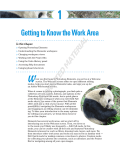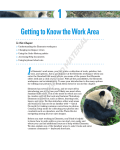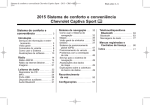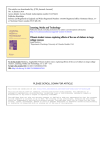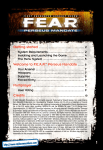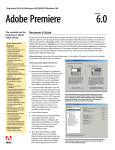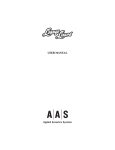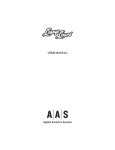Download Wiley Photoshop Elements 7 For Dummies
Transcript
1 AL Getting to Know the Work Area In This Chapter RI ▶ Opening Photoshop Elements TE ▶ Understanding the Elements workspace ▶ Changing workspace views MA ▶ Working with the Project Bin ▶ Using the Undo History panel ▶ Accessing Help documents TE D ▶ Using keyboard shortcuts W RI GH hen you first launch Photoshop Elements, you arrive at a Welcome screen. The Welcome screen offers you several choices for opening up some different editing modes, special Elements tasks that you can perform, and an opportunity to sign up for an Adobe Web-hosted service. CO PY When it comes to editing a photograph, you find quite a collection of tools, panels, buttons, and options in the Photoshop Elements Edit mode. Just a quick glance at the Elements workspace when you enter Full Edit mode shows you some of the power that Elements offers with just a click of your mouse. With all the possibilities, navigating the Elements workspaces and engaging in an editing session can be intimidating. To ease your introduction to the many options for editing your pictures, we break them down for you in this chapter. Elements has several work areas, and we start off by introducing you to the Welcome screen. Then, we move on to the mode you’ll likely use frequently — Full Edit mode. In this mode, you can be creative with all the tools and features Photoshop Elements is known for, such as filters, drawing tools, layers, and more. We then introduce other work areas and tools you may not be as familiar with — Quick Edit mode for making common corrections to photos; Creation mode for collecting your 10 Par t I: Get ting Started photos into creations, such as calendars; and the Project Bin for navigating among all your open images. Before you start working in Elements, you may find it helpful to know how to undo edits so that you can start over easily and find additional sources of help within Elements. We also explain one of the handiest ways to select tools and enter common commands: keyboard shortcuts. Elements 7 also has the Organizer, a powerful tool for acquiring your images and keeping them organized. The Organizer includes features that help you view and search for images, too. We introduce the Organizer in Part II. Launching Photoshop Elements 7 A great place to start in Elements is a central navigation area where you can choose what mode and activity you want to engage in. Well, that’s exactly what Adobe provides you when you open Photoshop Elements. It’s like the command center on the Starship Enterprise, except you won’t find Spock asking the computer any questions. The Welcome screen is easy to navigate and intuitive, as you can see in Figure 1-1. Here’s what you find in the Welcome screen: ✓ Photoshop.com Membership: For many generations of Photoshop Elements, Adobe has depended on third-party services for sharing files and placing orders for prints. You haven’t lost any Figure 1-1: The Photoshop Elements Welcome screen of these services, but appears when you launch Elements. Adobe has brought the sharing business under the fold of its own online servers. You get a whopping 2 gigabytes of hard-disk space to upload files and share them with friends. The best thing about the Photoshop.com service is that it’s free! Because this feature is closely related to sharing files, we include all the descriptions for using the service in Chapter 16. If you just can’t wait to get through all the things we talk about related to other features in Elements, jump to Chapter 16 and have a look at this new Photoshop Elements service. ✓ Organize: Click the Organize button to open the Organizer, where you can manage your collections of pictures stored on your hard drive. We cover using the Organizer and so many of its great features in Part II. Chapter 1: Get ting to Know the Work Area ✓ Edit: If you need to edit a photo, click the Edit button to access options for using either the Quick Fix mode to do some quick editing tasks or Full Edit mode, in which you can do the extraordinary editing jobs. ✓ Create: Click the Create button to move into the Create mode. In this mode, you can do some fancy things that Elements provides you, such as creating greeting cards, photo books, and calendars. ✓ Share: The Share workspace is all about sharing your photos. It’s all well and good to admire your own creations, but getting kudos from others can make you feel great. The Share workspace provides you options for creating an online album, e-mailing photos, printing your pictures, placing print orders, and copying photos to CD-ROMs and DVDs. We cover all you want to know about sharing your pictures in Chapter 16. If you know what you want to do in Elements, go ahead and click the appropriate button. But if you enter one mode and then decide you want to do something in another mode, Elements provides you the freedom to easily change modes from within the different workspaces. Just one more thing before we leave the Welcome screen. You can always return to the Welcome screen after you enter any editing mode. At the Figure 1-2: Click the house icon in the menu bar top of the Elements window in all in any editing mode to reopen the Welcome modes, a house icon appears, as shown in Figure 1-2. Click this icon to screen. open the Welcome screen again. Getting Around in Full Edit Mode Full Edit mode offers bundles of tools that you can use to edit your images, from correction tools for fixing color and clarity to filters, layers, and more for changing existing photos or creating entirely original images from scratch. But all these tools also make Full Edit mode complex. Figure 1-3 shows Elements in Full Edit mode, highlighting all the tools and features we discuss in the following sections. Jumping to Full Edit mode You can move into Full Edit mode in a couple of ways: ✓ From the initial Welcome screen: Click Edit and open a photo. Your Elements window appears in Full Edit mode, as shown in Figure 1-3. ✓ From the Organizer: Click a photo and click Fix. Click Full Edit to open the selected file in Full Edit mode. 11 12 Par t I: Get ting Started Tools panel System Welcome Filename Full Edit mode Shortcuts bar Menu bar Edit panel Organizer Quick Fix mode Share panel Creations panel Guided Help Photo Bin Image window Panels Bin Figure 1-3: The Photoshop Elements workspace appears when you open a file in Full Edit mode. You can also open a context menu (right-click your mouse button to make this menu appear) on a photo in the Organizer and select Full Edit from that menu to open the selected file in Full Edit mode. Examining the image window Not surprisingly, the image window’s tools and features are most useful when an image is open in the window. To get an image into the image window (as shown in Figure 1-3), follow these steps: 1. Choose File➪Open. The standard Open dialog box appears. It works like any ordinary Open dialog box you find in other applications. Chapter 1: Get ting to Know the Work Area 2. Move around your hard drive by using methods you know to open folders, and then select a picture. If you haven’t yet downloaded digital camera images or acquired scanned photos and want an image to experiment with, you can use an image found in your My Pictures folder that was installed with Windows. Elements installs some nice sample images with the application installation. Look in the Photoshop Elements 7\Tutorial folder to find some photos to play with. 3. After selecting a picture, click Open. The photo opens in a new image window in Elements. You can open as many image windows in Elements as your computer memory can handle. When each new file is opened, a thumbnail image is added to the Project Bin at the bottom of the screen (see Figure 1-3), and the image windows are stacked, with the current active image in the topmost window. To bring another open file to the foreground and make it active, click the respective thumbnail in the Project Bin. Here’s a quick look at important items in the image window, as shown in Figure 1-4: ✓ Scroll bars: Become active when you zoom in on an image. You can click the scroll arrows, move the scroll bar, or grab the Hand tool in the Tools panel and then drag within the Title bar Image area window to move the image. ✓ Magnification box: Shows you at a glance how much you have zoomed in or out. ✓ Information box: Shows you a readout for a particular tidbit of information. You can choose what information you want to see in this area by selecting one of the options from the pop-up menu, which we discuss in more detail later in this section. When you’re working on an image in Elements, you always Information box Size box want to know the physical image size, the image resolution, and Magnification box the color mode. (These terms Photo courtesy Corbis Digital Stock are explained in more detail in Figure 1-4: The image window displays an open Chapters 3 and 4.) Regardless of file within the Elements workspace. which menu option you select 13 14 Par t I: Get ting Started from the status bar, you can get a quick glimpse at these essential stats by clicking the Information box, which displays a pop-up menu like the one shown in Figure 1-5. ✓ Size box: Enables you to resize the window. Move the cursor to the box, and a diagonal line with two opposing arrows appears. When the cursor changes, drag in or out to size the window smaller or larger, respectively. You can also resize the window by dragging any of the corners in or out. Figure 1-5: Click the readout on the status bar, and a pop-up menu shows you important information about your file. ✓ Minimize button: The – button in the upperright corner of the image window. Click this button to hide the window from view. The window’s still open; you just click the image in the Project Bin to return the image to the previous size in the window. ✓ Maximize button: The button with the box-shaped icon. If you click this button, the Title bar shown at the top of the window disappears and provides you with a little more room for viewing images in the window. ✓ Close button: Shaped like an X. Click this button to close the active image window and keep Elements open. Alternatively, you can use the keyboard shortcut Ctrl/Ô+W or choose File➪Close to close the active window. After you’re familiar with the overall image window, we want to introduce you to the Information box’s pop-up menu, which enables you to choose the type of information you want to view in the Information box. Click the rightpointing arrow to open the menu, as shown in Figure 1-6. Here’s the lowdown of the options you find on the pop-up menu: ✓ Document Sizes: Shows you the saved file size. ✓ Document Profile: Shows you the color profile used with the file. Click to open pop-up menu ✓ Document Dimensions: As shown in Figure 1-6, shows you Figure 1-6: From the pop-up menu on the status the physical size in your default bar, select commands that provide information unit of measure, such as inches. about your file. Chapter 1: Get ting to Know the Work Area ✓ Scratch Sizes: Displays the amount of memory on your hard drive that’s consumed by all documents open in Elements. For example, 20M/200M indicates that the open documents consume 20 megabytes and that a total of 200 megabytes are available for Elements to edit your images. When you add more content to a file, such as new layers, the first figure grows while the second figure remains static. ✓ Efficiency: Indicates how many operations you’re performing in RAM, as opposed to using your scratch disk. When the number is 100%, you’re working in RAM. When the number drops below 100%, you’re using the scratch disk. If you continually work below 100%, it’s a good indication that you need to buy more RAM to increase your efficiency. ✓ Timing: Indicates the time it took to complete the last operation. ✓ Current Tool: Shows the name of the tool selected from the Tools panel. Don’t worry about trying to understand all these terms. The important thing to know is that you can visit the pop-up menu and change the items at will during your editing sessions. Moving through the menu bar Like just about every program you launch in Windows, Elements supports drop-down menus. The menus are logically constructed and identified to provide commands for working with your pictures (many commands that you don’t find supported in tools and on panels). A quick glimpse at the menu names gives you a hint of what might be contained in a given menu list. Here are the ten different menus: ✓ File: Just as you might suspect, the File menu contains commands for working with your picture as a file. You find commands in the menu list for saving, opening, processing, importing, exporting, and printing. We cover saving files in Chapter 3 and printing or exporting for other output in Part V. ✓ Edit: The old-fashioned Copy, Cut, and Paste commands are located in this menu. Additionally, you have some important file settings commands on the menu, including preferences, which we cover in more detail in Chapter 2. ✓ Image: You use the Image menu most often when you want to effect changes to the entire image, such as changing a color mode or cropping, rotating, and resizing the image. For details about sizing and color modes, check out Chapter 3. For more about cropping and rotating images, flip to Chapter 9. 15 16 Par t I: Get ting Started ✓ Enhance: Just the name of this menu should tell you what commands to expect here. This is where you go to change the appearance of an image, such as changing its brightness and contrast, adjusting its color and lighting, and doing some other smart fix-up work to improve its appearance. On the Enhance➪Adjust Color submenu, you find a number of commands that offer you a variety of color adjustments. Look to Chapter 10 for some detail on correcting color. In Chapters 9 and 10, you can find out how to use correction tools so that your images look their best. ✓ Layer: As we describe in great detail in Chapter 8 (a whole chapter just about layers), most kinds of editing you do in Elements are best handled by using layers. Elements neatly tucks away most of the relevant commands associated with working in layers right in this menu. ✓ Select: Of just about equal importance to layers are selections. Whereas the Image menu contains commands that are applied to the entire image, you can edit isolated areas of an image by using the commands on the Select menu. To isolate an area, you need to create a selection, as we explain in Chapter 7. This menu contains commands to help you with many essential tasks related to working with selections. ✓ Filter: The Filter menu is where you find some professional photographic darkroom techniques, or you can completely leave the world of photography and explore the world of a fine artist. With tons of different filter commands, you can create some extraordinary effects. Find out all about filters in Chapter 11. ✓ View: Zooming in and out of images, turning on a grid, exposing horizontal and vertical rulers, adding annotations, and checking out the print size of your pictures are handled on the View menu. Chapter 5 unearths secrets of the Zoom tool, rulers, and more. ✓ Window: Elements supports a number of different panels, as we explain in the section “Playing with panels,” later in this chapter. Elements has so many panels that keeping them all open at one time is impractical. Thanks to the Window menu, you can easily view and hide panels, reopen the Welcome window, tile and cascade open windows, and bring inactive windows to the foreground. ✓ Help: We hope that you get all the help you need right here in this book; but just in case we miss something (or your neighbor has borrowed it, fine book that it is), you have some interactive help right at your mousetip on the Help menu. The menu also offers links to the Adobe Web site for more information and a little assistance, courtesy of the tutorials accessible from this menu. (Find a little more detail about accessing help in the section “Getting a Helping Hand,” later in this chapter.) Chapter 1: Get ting to Know the Work Area Uncovering the context menus Context menus are common to many programs, and Photoshop Elements is no exception. They’re those little menus that appear when you right-click (Windows) or Control+click (Mac), offering commands and tools related to whatever area or tool you right-clicked. The context menus are your solution when you may be in doubt about where to find a command on a menu. You just right-click an item, and a pop-up menu opens. Before you become familiar with Photoshop Elements and struggle to find a menu command, always try to first open a context menu and look for the command you want in the menu list. Because context menus provide commands respective to the tool you’re using, the menu commands change according to what tool or feature you’re using and where you click at the moment you open a context menu. For example, in Figure 1-7, you can see the context menu that appears after we create a selection marquee and right-click that marquee in the image window. Notice that the commands are all related to selections. Using the Tools panel Elements provides a good number of panels for different purposes. The one that you’ll find you use most is the Tools panel. In panel hierarchy terms, you typically first click a tool in the Tools panel, and then use another panel for additional tool options or use the Options bar (which we describe in the section “Selecting tool options in the Options bar,” later in the chapter) for finetuning your tool instruments. More often than not, clicking a tool in the Tools panel is your first step in most editing sessions. You can easily access tools in Elements by pressing shortcut keys on your keyboard. For a quick glance at the Tools panel and the keystrokes Figure 1-7: A context menu for needed to access the tools, look over Figure 1-8. selections. Notice in the Tools panel that several tools appear with a tiny arrow pointing right and downward in the lower-right corner of each tool. Whenever you see this arrowhead, remember that more tools are nested within that tool group. Click a tool with an arrowhead and hold down the mouse button, or for a faster response from Elements, just 17 18 Par t I: Get ting Started right-click a tool. A pop-up toolbar opens, as shown in Figure 1-9, and offers you more tool selections within that group. V Z H I To select tools within a tool group by using keystrokes, M hold down the Shift key and strike the respective key W (as shown in Figure 1-8) to access the tool. Keep the Shift key down and repeatedly press the shortcut key T to step through all tools in a given group. L Q P Y J S E B F K G U R Whether you have to press the Shift key to select tools is controlled by a preference setting. To change the default setting so that you don’t have to press Shift, choose Edit➪Preferences➪General or press Ctrl/Ô+K. The shortcuts work for you at all times except when you’re typing text with the cursor active inside a text block. Be certain to click the Tools panel to select a tool when you finish editing some text. The tools are varied, and you may find that you don’t use all the tools in the Tools panel in your workflow. Rather than describe the tool functions here, we address the tools in the rest of this book as they pertain to the respective Elements tasks. Playing with panels A C O X D Figure 1-8: You access tools by clicking the tool in the Tools panel or typing a keyboard shortcut on your keyboard. Elements provides you with a bunch of panels that contain settings and options used to refine the tools you select in the Tools panel and tasks you perform to edit images. Assume for a moment that you want to let your creative juices loose and create a Picasso-esque painting — something that you can do easily in Photoshop Elements. First, click the Brush tool and then click a color in the Color Swatches panel. On a new canvas, you begin to paint. When you want to change color, click again in the Color Swatches panel on a different color. This kind of interactivity between the Tools panel and another panel is something you frequently use in Elements. Figure 1-9: Click and hold the mouse button on a tool that has a tiny arrowhead to make a pop-up toolbar open. Chapter 1: Get ting to Know the Work Area Panels are accessed from either the Panels Bin or the Window menu. Many options in panels are intuitive. To become familiar with various panel options, just poke around a little, and most of the options will become familiar to you. Selecting tool options from the Options bar When you click a tool in the Tools panel, the Options bar offers you choices specific to a selected tool. Figure 1-10 shows the options available when the Brush tool is selected. Figure 1-10: The Options bar provides attribute choices for a tool selected in the Tools panel. Juggling all your interface options With all the settings you can use for any given tool, trying to figure out exactly where to select an option for the edit you want to make can become downright frustrating. To help simplify the process of using tools and selecting options for the tools, here’s what you might do in your normal workflow: 1. Select a tool in the Tools panel. Obviously, you need to know what task you want to perform, so selecting the proper tool to complete the task is important to know up front. 2. Take a quick look at the Options bar. Before moving to other option choices, be certain that you look over the choices on the Options bar. If you want to use a tool such as the Brush tool or the Clone Stamp tool, perhaps you want to make a decision about what size brush tip you want to use. This choice is specific to the selected tool and therefore appears as an Options bar choice. 3. Open a panel for more options. If you want to use the Brush tool to apply some color to an image, for example, after you select the Brush tip on the Options bar, open the Color Swatches panel and select a color. 4. Open a drop-down menu. Not all tools support a drop-down menu in the Options bar. When you see a down-pointing arrow, click the arrow to open a menu in which you can find more options for some tools. 19 20 Par t I: Get ting Started 5. Get some help. When you hover your cursor over a tool, you see that tool described in blue text. Click the blue text, and your default Web browser opens, displaying a page on Adobe’s Web site where help information and tips describe using the respective tool. You’ll also find blue text in the More menu. The blue text alerts you to help information that can be shown in your Web browser. Try following the same sequence when you want to edit images in Elements by first selecting a tool and then checking out the Options bar, opening panels related to providing choices for the task at hand, clicking drop-down menus for additional choices in the panels, and getting some help when you need it. Looking at shortcuts You find the Shortcuts bar to the right of the Options bar and below the Edit, Create, and Share buttons. The Shortcuts bar, as shown in Figure 1-11, serves several purposes: ✓ Quick access to editing tasks: Buttons permit you to quickly access the Full Edit or Quick Edit modes. The Guided button is used for accessing step-bystep instructions on common editing tasks. Elements Edit mode Open Creations panel Open Sharing panel ✓ Quick access to other Elements functions: Buttons appear for quick access to other Elements Full Edit Quick Fix Quick Help functions that involve creatmode mode ing calendars, photo collages, online galleries, and slide shows. Figure 1-11: The Shortcuts bar appears to the right of the Elements window and offers The Share button offers many options to engage in different editing modes. options for sharing photos online and via e-mail attachments, ordering photo prints online, and replicating CD/DVDs. Depending on your editing mode, such as Full Edit, Quick Edit, or Create and Share, the panels change to reflect editing options for a given editing mode. Chapter 1: Get ting to Know the Work Area Shortcuts contain tools and buttons grouped as follows: ✓ Edit: Click this button to toggle the Full Edit and Quick Edit modes or access the Guided Help. ✓ Create: Click this button to create Photo Books, Photo Collages, Slide Shows, Order Prints, and create Greeting Cards. Click More Options in the Create panel to access additional creation options. ✓ Share: Click this button to access options that offer many different ways to share your photos with others. In the Share panel, you find options for creating an Online Album, sending photos via e-mail attachments, using Photo Mail, ordering prints online, and writing CDs and DVDs of photo collections and slide shows. Clicking More Options in the Share panel offers additional options for sharing photos. Changing Workspaces When you’re in Full Edit mode, which we discuss in preceding sections, you can apply any kind of edits to a picture, improve the picture’s appearance, and apply all that Elements offers you. This mode is the richest editor in Elements, in terms of accessing all features. Because Elements has so many different kinds of editing opportunities, the program offers you other workspace views, tailored to the kinds of tasks people typically want to perform. Using Quick Edit mode Quick Edit mode is designed to provide you with just those tools that you need to prepare a picture for its intended destination, whether it’s printing, onscreen viewing, or one of the other organizing items. Use this mode to make your pictures look good. You don’t find tools for adding text, painting with brushes, or applying gradients in Quick Edit mode. Rather, what you find is a completely different set of panels for balancing contrast and brightness, lighting, and sharpening, for example. This mode is like having a digital darkroom on your desktop, where you take care of perfecting an image like you would in analog photography darkrooms. To enter Quick Edit mode while you’re in Full Edit mode, click the Quick button adjacent to the Options bar; the view changes, as shown in Figure 1-12. 21 22 Par t I: Get ting Started Figure 1-12: Click Quick in Full Edit mode to change the workspace. Here are several differences between Full Edit mode and Quick Edit mode: ✓ Completely different sets of panels are docked in the Panels Bin. All the panels in Quick Edit mode are related to adjusting brightness controls and are designed to improve the overall appearance of your pictures. In addition, all the Windows menu commands for accessing panels are grayed out. While you work in Quick Edit mode, Elements insists on limiting your use of panels to just the ones docked in the Panels Bin. Moreover, you can’t undock panels from the Panels Bin by dragging them out, as you can in other modes. ✓ The Tools panel disappears. Quick Edit mode offers only these tools in the Tools panel: • Zoom • Hand • Magic Selection Brush • Crop None of the other Elements tools is accessible while you work in this mode. Chapter 1: Get ting to Know the Work Area If you’ve used an earlier version of Photoshop Elements, you may remember that you had a Red Eye Removal tool in the Tools panel in Quick Edit mode. The Red Eye Removal tool options are still available in Elements 7, but the options appear in only the General Fixes panel. ✓ Multiple viewing options are available. Notice in Figure 1-12 that you see two views of the same image. The Before view on the left displays the raw, unedited image. The After view shows you the results of changes you make with panel options and menu commands. You select different viewing modes from menu choices in the View drop-down menu below the image window. If you want to return to Full Edit mode, click the Full button. Using creation tools To organize your pictures for display in a variety of different ways, begin by clicking the Create button. The panels in the Panels Bin change to support different creation options. Click one of the listed options for making a new creation or click the More Options button to select from additional options. In Figure 1-13, we clicked the Create button and then clicked the Photo Collage button to start a new creation for a photo collage. As you can see in Figure 1-13, the Panels Bin changed to reflect options available to us for creating our photo collage. We cover each option available in the various creation panels in greater detail in Chapter 16. Using the Project Bin The Project Bin displays thumbnail views of all your open images. Regardless of whether you work in Full Edit or Quick Edit mode, you can immediately see a small image of all the pictures you have open at one time, as shown in Figure 1-14. You can also see thumbnail views of all the different views you create for a single picture. Find out all the details in the following sections. Figure 1-13: Click Create and then choose an option for the If you want to rearrange the thumbnails in the type of creation you want to Project Bin, click and drag horizontally to reorga- edit. nize the order of the thumbnails. 23 24 Par t I: Get ting Started Figure 1-14: All open pictures and new views are displayed as thumbnails in the Project Bin. Creating different views of an image What? Different views of the same picture, you say? Yes, indeed. You might create a new view when you want to zoom in on an area for some precise editing and then want to switch back to a wider view. Here’s how you do it: 1. Double-click a thumbnail image in the Project Bin. That photo appears in the image window as the active document. 2. Choose View➪New Window for <filename>. Note that <filename> is the name of the file in the image window. 3. Zoom to the new view. A new view appears for the active document, and you see another thumbnail image added to the Project Bin. To zoom quickly, click the Zoom tool and click a few times on the picture in the image window to zoom into the photo. 4. Toggle views of the same image. Double-click the original thumbnail to see the opening view; double-click the other thumbnail to see the zoomed view. Hiding the Project Bin The Project Bin takes up a lot of room at the bottom of the image window, and you’re not likely to want it open all the time while editing pictures. Fortunately, Elements provides you with several methods for hiding the Project Bin when you want to create a little more editing real estate. To temporarily hide the Project Bin, do one of the following: ✓ Place the cursor over the separator bar between the image window and the Project Bin. When the cursor changes to two horizontal lines with vertical opposing arrowheads, drag down to collapse the Project Bin. When the Bin is collapsed, drag up the separator bar to open it. ✓ Double-click the separator bar to hide the Project Bin. Chapter 1: Get ting to Know the Work Area ✓ Click the Hide Project Bin text at the bottom of the Project Bin. ✓ Open a context menu by right-clicking and select Close at the top of the menu. Using Bin Actions A nice feature in Elements is the Bin Actions menu at the top of the Project Bin. Click Bin Actions to start a new creation, share photos, print all the files open in the Bin, and save the Bin files as an album. To the left of the Bin Actions menu, you’ll find another feature for viewing files in Elements. The Show Open Files (shown by default) is another drop-down menu that offers the default option for showing open files and another choice for showing files from the Organizer. Choose Show Files from Organizer to add the files in your Organizer to the Project Bin. Retracing Your Steps Ever since Apple’s Macintosh brought a windows interface to the masses, the Undo command has been one of the most frequently used menu commands in every program developed. You make a change to your document, and if you don’t like it, you simply choose Edit➪Undo or press the keyboard shortcut Ctrl/Ô+Z. In Elements, your options to undo your work provide you much more than reverting back to the last view, as we explain in the following sections. Using the Undo History panel Elements takes the Undo command to new levels by offering you a panel in which all (well, almost all) your changes in an editing session are recorded and available for undoing at any step in an editing sequence. Each edit you make is recorded in the Undo History panel. To open the panel, choose Window➪Undo History. Make changes to your document, and each step is recorded in the panel, as you see in Figure 1-15. If Elements slows down and you’re moving along at a snail’s pace, open the More fly-away menu in the Undo History panel and choose Clear Undo History. Elements flushes all the recorded history and frees up some precious memory that often enables you to work faster. We said almost all steps are recorded because the number of steps the History panel can record is controlled by a preference setting that tops out 25 26 Par t I: Get ting Started at 1,000 steps. If you choose Edit➪Preferences (Windows) and look at the Performance preferences, as we explain in more depth in Chapter 2, the number of history states (times you can go back in history and undo) defaults to 50. You can change the number to the maximum 1,000, if you like. But realize that the more history states you record, the Figure 1-15: The Undo History panel is shown with the flymore memory Elements away menu open. requires. To undo the last edit, you can use the keyboard shortcut Ctrl/Ô+Z. When you want to undo multiple edits, open the Undo History panel and click any item listed in the panel. Elements takes you to that last edit while scrubbing all edits that follow the selected item. If you want to bring back the edits, just click again on any step appearing grayed out in the panel to redo up to that level. All your steps are listed in the Undo History panel as long as you remain in Elements and don’t close the file. When the file is closed, all history information is lost. Reverting to the last save While you work away in Elements, always plan on saving your work regularly. Each time you save in an editing session, the Undo History panel preserves the list of edits you made before the save and up to the maximum number of history states defined in the General preferences. If you save, then perform more edits, and then want to return to the last saved version of your document, Elements provides you with a quick, efficient way to do so. If you choose Edit➪Revert, Elements eliminates your new edits and takes you back to the last time you saved your file. When you choose Revert, Revert appears in the Undo History panel. You can eliminate the Revert command from the Undo History panel by right-clicking Revert in the Undo History panel and choosing Delete from the context menu that appears. This command returns you to the edits made after the last save. Chapter 1: Get ting to Know the Work Area Getting a Helping Hand You can reach for this book whenever you want some details about accomplishing a task while working in Elements. However, for those little annoying moments, and just in case some coffee stains blot out a few pages in this book, you may want to look for an alternative feature description from another source. Rather than accumulate a library of Elements books, all you need to do is look at Elements itself to find some valuable help information quickly and easily. If you’re stuck on understanding some feature, ample help documents that are a mouse click away can help you overcome some frustrating moments. Using Help Your first stop in exploring the helpful information Elements provides is on the Help menu. In this menu, you can find several menu commands that offer information: ✓ Photoshop Elements Help: Choose Help➪Photoshop Elements Help or press the F1 key to open the Elements Help file. You can type a search topic and press Enter to open a list of items that provide helpful information about the searched words. For quick access to the Help document, type the text you want to search into the text box on the right side of the menu bar in Full Edit or Quick Edit mode. ✓ Glossary of Terms: While you read this book, if we use a term that you don’t completely understand, open the Photoshop Elements glossary. In this glossary, you can find definitions of terms commonly used in photography and image editing, as well as terms related specifically to Elements. ✓ Online Support: This menu command launches your default Web browser and takes you to the Adobe Web site, where you can find information about Elements, problems reported by users, and some work-around methods for getting a job done. Additional Web assisted help information is available by clicking Photoshop Elements Online and Online Learning Resources. The vast collection of Web pages on Adobe’s Web site offers you assistance, tips and techniques, and solutions to many problems that come with editing images. Be sure to spend some time browsing these Web pages. 27 28 Par t I: Get ting Started Using PDFs from the installation CD A number of bonus files are stored in PDF form on your installation CD. PDF files require the free Adobe Reader program or one of the commercial Acrobat viewers. Adobe Reader can be installed from the CD during the installation process. Depending on when you purchased your Elements installer CD, the version of Adobe Reader on the CD may be outdated. If you want to stay with the latest upgrade of Adobe Reader, open your Web browser and type this address in the address bar: www.adobe.com/products/reader Adobe Systems provides easy, step-by-step instructions for downloading the most current, free Adobe Reader program and installing it on your computer. If you haven’t upgraded to at least Adobe Reader 9, be sure to download the most recent version of Adobe Reader. Adobe Reader 9 and higher provide you with some direct connections to Acrobat.com, where you can expand your Photoshop.com storage space to over 7GB (gigabytes). Look at Chapter 16, in which we talk about using Photoshop.com and expanding your online libraries with Acrobat.com. Using ToolTips While you move your cursor around tools and panels, pause a moment before clicking the mouse. A slight delay in your actions produces a ToolTip. Elements provides this sort of dynamic help when you pause the cursor before moving to another location.





















